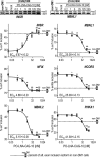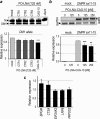Short antisense-locked nucleic acids (all-LNAs) correct alternative splicing abnormalities in myotonic dystrophy
- PMID: 25753670
- PMCID: PMC4381072
- DOI: 10.1093/nar/gkv163
Short antisense-locked nucleic acids (all-LNAs) correct alternative splicing abnormalities in myotonic dystrophy
Abstract
Myotonic dystrophy type 1 (DM1) is an autosomal dominant multisystemic disorder caused by expansion of CTG triplet repeats in 3'-untranslated region of DMPK gene. The pathomechanism of DM1 is driven by accumulation of toxic transcripts containing expanded CUG repeats (CUG(exp)) in nuclear foci which sequester several factors regulating RNA metabolism, such as Muscleblind-like proteins (MBNLs). In this work, we utilized very short chemically modified antisense oligonucleotides composed exclusively of locked nucleic acids (all-LNAs) complementary to CUG repeats, as potential therapeutic agents against DM1. Our in vitro data demonstrated that very short, 8- or 10-unit all-LNAs effectively bound the CUG repeat RNA and prevented the formation of CUG(exp)/MBNL complexes. In proliferating DM1 cells as well as in skeletal muscles of DM1 mouse model the all-LNAs induced the reduction of the number and size of CUG(exp) foci and corrected MBNL-sensitive alternative splicing defects with high efficacy and specificity. The all-LNAs had low impact on the cellular level of CUG(exp)-containing transcripts and did not affect the expression of other transcripts with short CUG repeats. Our data strongly indicate that short all-LNAs complementary to CUG repeats are a promising therapeutic tool against DM1.
© The Author(s) 2015. Published by Oxford University Press on behalf of Nucleic Acids Research.
Figures






Similar articles
-
Systemic therapy in an RNA toxicity mouse model with an antisense oligonucleotide therapy targeting a non-CUG sequence within the DMPK 3'UTR RNA.Hum Mol Genet. 2020 Jun 3;29(9):1440-1453. doi: 10.1093/hmg/ddaa060. Hum Mol Genet. 2020. PMID: 32242217 Free PMC article.
-
Systemic Evaluation of Chimeric LNA/2'-O-Methyl Steric Blockers for Myotonic Dystrophy Type 1 Therapy.Nucleic Acid Ther. 2020 Apr;30(2):80-93. doi: 10.1089/nat.2019.0811. Epub 2019 Dec 23. Nucleic Acid Ther. 2020. PMID: 31873063 Free PMC article.
-
Reduced cytoplasmic MBNL1 is an early event in a brain-specific mouse model of myotonic dystrophy.Hum Mol Genet. 2017 Jun 15;26(12):2247-2257. doi: 10.1093/hmg/ddx115. Hum Mol Genet. 2017. PMID: 28369378
-
Recent Progress and Challenges in the Development of Antisense Therapies for Myotonic Dystrophy Type 1.Int J Mol Sci. 2022 Nov 1;23(21):13359. doi: 10.3390/ijms232113359. Int J Mol Sci. 2022. PMID: 36362145 Free PMC article. Review.
-
Therapeutic Approaches for Dominant Muscle Diseases: Highlight on Myotonic Dystrophy.Curr Gene Ther. 2015;15(4):329-37. doi: 10.2174/1566523215666150630120537. Curr Gene Ther. 2015. PMID: 26122101 Review.
Cited by
-
Non-invasive monitoring of alternative splicing outcomes to identify candidate therapies for myotonic dystrophy type 1.Nat Commun. 2018 Dec 7;9(1):5227. doi: 10.1038/s41467-018-07517-y. Nat Commun. 2018. PMID: 30531949 Free PMC article.
-
Systemic therapy in an RNA toxicity mouse model with an antisense oligonucleotide therapy targeting a non-CUG sequence within the DMPK 3'UTR RNA.Hum Mol Genet. 2020 Jun 3;29(9):1440-1453. doi: 10.1093/hmg/ddaa060. Hum Mol Genet. 2020. PMID: 32242217 Free PMC article.
-
Peptide-conjugated oligonucleotides evoke long-lasting myotonic dystrophy correction in patient-derived cells and mice.J Clin Invest. 2019 Nov 1;129(11):4739-4744. doi: 10.1172/JCI128205. J Clin Invest. 2019. PMID: 31479430 Free PMC article.
-
Molecular genetics of myotonic dystrophy and the evolution of therapeutic approaches.J Hum Genet. 2025 Jul 3. doi: 10.1038/s10038-025-01358-6. Online ahead of print. J Hum Genet. 2025. PMID: 40603638 Review.
-
Cyclic mismatch binding ligands interact with disease-associated CGG trinucleotide repeats in RNA and suppress their translation.Nucleic Acids Res. 2021 Sep 20;49(16):9479-9495. doi: 10.1093/nar/gkab669. Nucleic Acids Res. 2021. PMID: 34358321 Free PMC article.
References
-
- Ashizawa T., Sarkar P.S. Myotonic dystrophy types 1 and 2. Handb. Clin. Neurol. 2011;101:193–237. - PubMed
-
- Brook J.D., McCurrach M.E., Harley H.G., Buckler A.J., Church D., Aburatani H., Hunter K., Stanton V.P., Thirion J.P., Hudson T., et al. Molecular basis of myotonic dystrophy: expansion of a trinucleotide (CTG) repeat at the 3′ end of a transcript encoding a protein kinase family member. Cell. 1992;68:799–808. - PubMed
Publication types
MeSH terms
Substances
Grants and funding
LinkOut - more resources
Full Text Sources
Other Literature Sources

